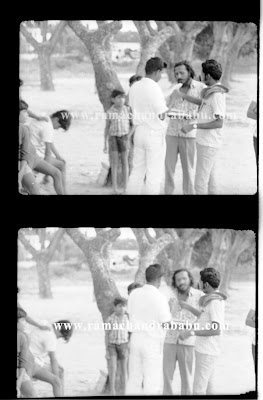We had many foreign students studying in various departments during my
days at the Film Institute (1968-71). They were mostly from Afghanistan,
Africa, Singapore and from neighbouring countries Nepal, Bhutan,
Ceylon etc.Each course had quota for two Foreign students and were
mostly filled up. In our Cinematography class were Prem Kumar Upadhyaya
from Nepal and Naapo Gbande from Ghana. Since Prem knew Hindi very well,
we never felt he was a foreigner. Naapo was the most silent one who
always spoke in a soft voice.Though he was much older than many of us,
he looked young , tall and trim with a thin figure. Away from home he
was a little bit homesick and always had a worried look. In due course
we all became friends and he became happy and concentrated in his
studies.
 | |
| As a model in Lighting exercise |
We used to have Lighting exercises in our Still Photography classes and
we ourselves used to stand in as Model for each others practicals. Also
we worked as a three member unit for our cinematography exercises etc.
Remember the photo,
I published many years back in this Blog which was the main reason for
me to write this Blog on my Institute days. The person pushing the dolly
is Naapo Gbande and I am there holding the reflector while Jaya Bhaduri
faces the camera handled by Mr.Edwards.
 |
| Camera Practicals - Naapo pushing the Dolly |
During the strike at the Film Institute,
all foreign students supported me and stood by me at all times. In fact
Naapo and David Ankora ( Sound Engineering) were always beside me to
protect me from any intended attack by the Acting students.
 |
| David, me and Naapo |
When it was time to leave the Institute a whole lot of my foreign
friends turned up at the railway station to see me off. Almost half of
my friends in the photograph are from far off lands.
 |
| Send off at Poona Railway station |
We parted ways....immersed in our life and work we could not communicate
with them later on. Meanwhile my batch mates Ramlal Agarwal and Debu
Deodhar passed away some years back. Last month in the International
Dilm Festival of Kerala held at Thiruvananthapuram there were some films
from Ghana. I wanted to meet those film makers to inquire about my old
friends Naapo and David. But somehow I missed meeting them. I thought
of using the Internet to start searching for Naapo and I came to know of
the sad news that he passed away on October 17 th 2015.
 |
| Naapo in Ghana |
Given below is an obituary written by Kouame
Koulibaly :
A great cinematographer is gone
The film
industry in Ghana lost one of its extremely brilliant cinematographers when Mr
Naapo Gbande died on October 17,
2015 at the 37 Military Hospital in
Accra. He was 76.
Mr
Gbande worked for several years with the defunct Ghana Film Industry Corporation
(GFIC) where he shot numerous newsreels, documentaries and feature films.
He later
moved on to the National Film and Television
Institute (NAFTI) as a lecturer and many of the current professional
cinematographers in this country passed through his hands.
The
soft-spoken Mr Gbande worked as the cinematographer on several projects with
veteran film director, Mr Kwaw Ansah, who described him as an extremely
creative and diligent collaborator.
“I
worked with him on Harvest At 17, Love Brewed In The African Pot, Heritage
Africa and several television commercials.
“He
always tried to get images that truly complemented the essence of whatever was
being shot. His work brought true meaning
to the functions of a DOP on a
film set,” Mr Ansah said.
A native
of Kpandai in the Northern Region, Mr Gbande realised early in life that
photography was his calling and he
diligently pursued it throughout his working life. Mr
Gbande was trained in film photography at the Film and Television Institute of
India at Pune in the Indian state of Maharashtra.
Experienced
lighting technician, Mr Tetteh ‘Wrally’ Apain,
worked with Mr Gbande on numerous productions and they remained close
friends.
“I
enjoyed being on a set with him because he always knew what he was about. He
truly understood what photography was about and every lighting technician
cherished his presence during productions,” Mr Apain said about his late
friend.
Apart
from his teaching and practical work, Mr
Gbande was also a facilitator at several cinema workshops in this country and abroad and he published
practical guides on lighting and camera movement.
The late cinematographer will be buried on
Saturday, November 14, 2015 at the Madina Cemetery in Accra. He will be sorely missed by the film making
fraternity.
Adieu my friend, though we couldn't meet afterwards your memory will always linger in our minds forever. Rest In Peace

.jpg)







.jpg)











